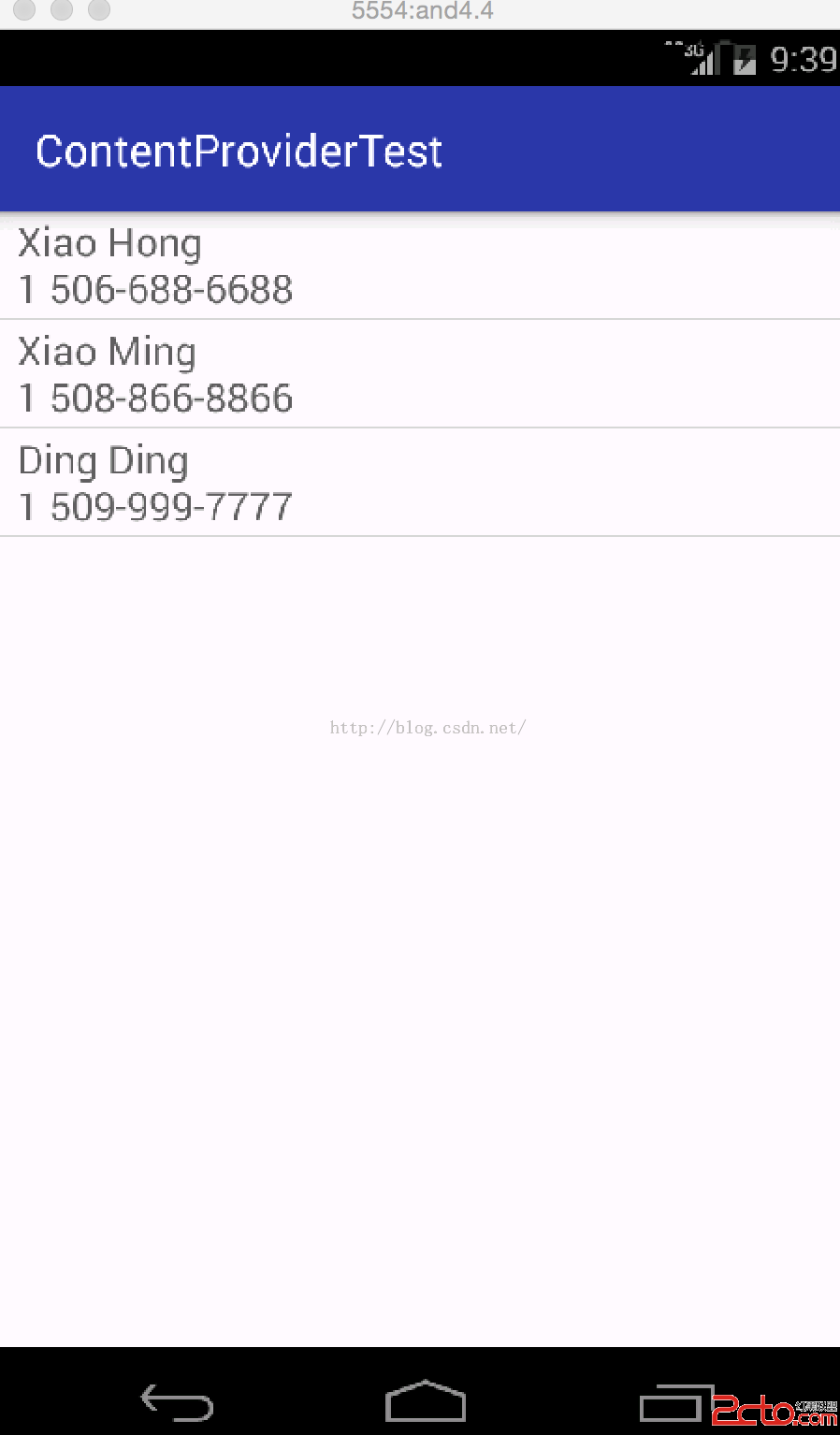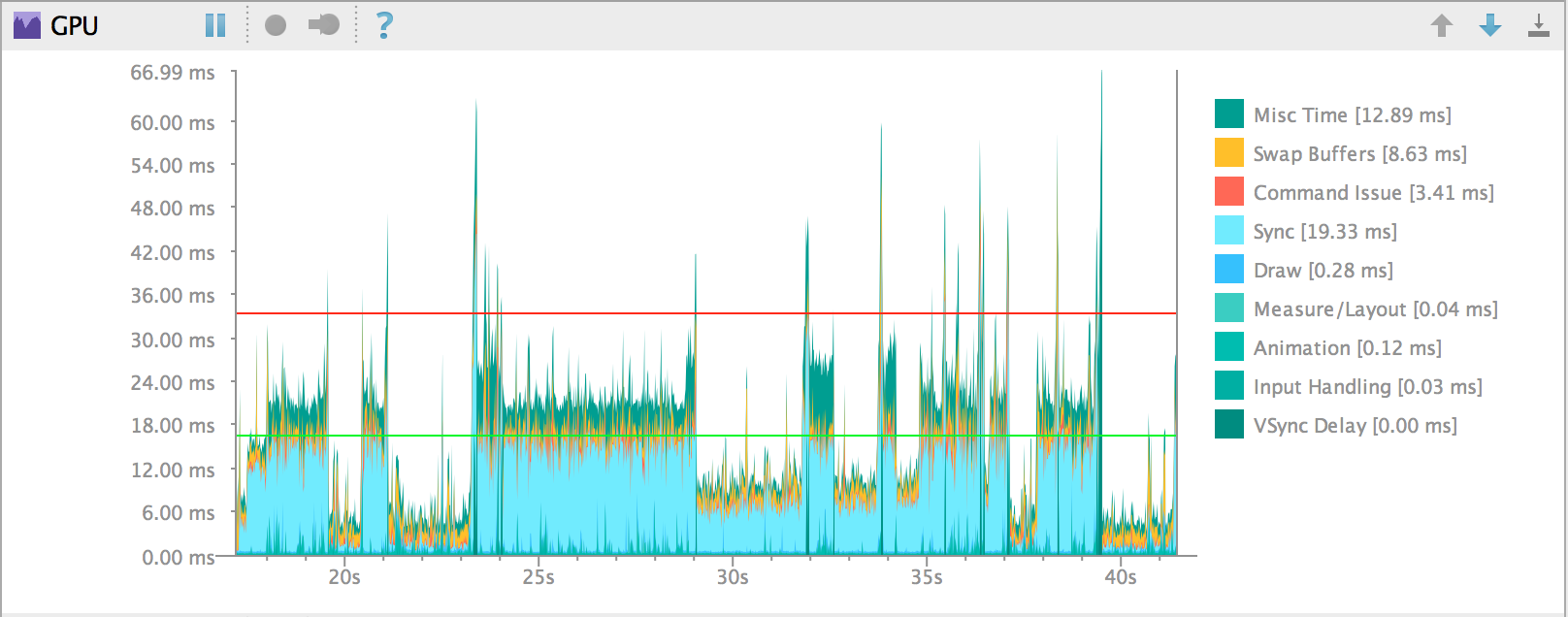編輯:關於Android編程
紋理,在openGL中,可以理解為加載到顯卡顯存中的圖片。Android設備在2.2開始支持openGL ES2.0,從前都是ES1.0 和 ES1.1的版本。簡單來說,openGL ES是為了嵌入設備進行功能剪裁後的openGL版本。ES2.0是和1.x版本不兼容的,區別和兼容性參見android 官方文檔。
首先,android使用openGL提供了特殊的view作為基礎叫做GLSurfaceView。我們的view需要繼承GLSurfaceView。如下簡單示例:
public class MyGLSurfaceView extends GLSurfaceView {
public MyGLSurfaceView(Context context) {
super(context);
setFocusableInTouchMode(true);
// Tell the surface view we want to create an OpenGL ES 2.0-compatible
// context, and set an OpenGL ES 2.0-compatible renderer.
this.setEGLContextClientVersion(2);
this.setRenderer(new MyRenderer());
}
}
public class MyRenderer implements Renderer {
public void onDrawFrame(GL10 gl) {}
public void onSurfaceChanged(GL10 gl, int width, int height) {}
public void onSurfaceCreated(GL10 gl, EGLConfig config) {}
}接口實現3個方法,對應繪制,繪制區域變化,區域創建。需要說明的是參數GL10 gl是openGL es1.x版本的對象。這裡我們不會使用到。還有一點就是,onDrawFrame方法的調用是有系統調用的,不需要手動調用。系統會以一定的頻率不斷的回調。
接下來我們進入ES2.0的使用,先上代碼:
public void onSurfaceCreated(GL10 gl, EGLConfig config) {
GLES20.glEnable(GLES20.GL_TEXTURE_2D);
// Active the texture unit 0
GLES20.glActiveTexture(GLES20.GL_TEXTURE0);
loadVertex();
initShader();
loadTexture();
}
繪制區域創建的時候,我們設置了啟用2D的紋理,並且激活了紋理單元unit0。什麼意思呢,說起來話長,以後慢慢說。簡單說一下,記住openGL是基於狀態的,就是很多狀態的設置和切換,這裡啟用GL_TEXTURE_2D就是一個狀態的開啟,表明openGL可以使用2D紋理。
那神馬是激活紋理單元,這個和硬件有點關系,openGL要顯卡會劃分存儲紋理的存儲區域不止一個區域。這裡是使用區域 unit 0,多重紋理繪制可以開啟多個,這個以後說。接下來,調用了三個函數,載入頂點,初始化著色器,載入紋理。
第一,載入頂點,openGL繪制圖形是根據頂點以後鏈接起來的。為什麼要這樣,其實這樣很強大是一種設計吧。頂點可以暫時簡單理解為含有位置信息的坐標點。展開代碼如下:
private void loadVertex() {
// float size = 4
this.vertex = ByteBuffer.allocateDirect(quadVertex.length * 4)
.order(ByteOrder.nativeOrder())
.asFloatBuffer();
this.vertex.put(quadVertex).position(0);
// short size = 2
this.index = ByteBuffer.allocateDirect(quadIndex.length * 2)
.order(ByteOrder.nativeOrder())
.asShortBuffer();
this.index.put(quadIndex).position(0);
}
private FloatBuffer vertex;
private ShortBuffer index;
private float[] quadVertex = new float[] {
-0.5f, 0.5f, 0.0f, // Position 0
0, 1.0f, // TexCoord 0
-0.5f, -0.5f, 0.0f, // Position 1
0, 0, // TexCoord 1
0.5f , -0.5f, 0.0f, // Position 2
1.0f, 0, // TexCoord 2
0.5f, 0.5f, 0.0f, // Position 3
1.0f, 1.0f, // TexCoord 3
};
private short[] quadIndex = new short[] {
(short)(0), // Position 0
(short)(1), // Position 1
(short)(2), // Position 2
(short)(2), // Position 2
(short)(3), // Position 3
(short)(0), // Position 0
};FloatBuffer,ShortBuffer是封裝了本地數據結構的封裝對象。是的,這個2個對象裡面的數據不被java虛擬機管理,相當於C語言的存儲方式。具體的介紹可以參看這裡(想了解的猛擊)。 quadVertex的數據就是一個矩形的坐標,和紋理坐標。一兩句話很難解釋清楚,這裡涉及到openGL的幾個經典的坐標系,下次說。概括的說,openGL的坐標是單位化的,都是0.0-1.0的浮點型,屏幕的中心點是(0,0)。而紋理的坐標左下角是(0,0)。 這裡的quadVertex是在屏幕中大概花了一個矩形貼了一個圖片, position0 是左上點,以後左下,右下,右上的順序,紋理坐標同理。
quadIndx神馬意思呢,就是這剛才的這些頂點索引排列。這裡一個矩形也就4個頂點,每個頂點3個位置坐標,2個紋理坐標。也就是說一個頂點有5個float數據。至於為什麼頂點為什麼這麼排列下次說,是2個三角形合成了一個矩形,幾句話很難解釋清楚。
所以說,這段代碼就是把矩形的位置和紋理坐標,存儲到本地數據,准備後面使用而已。
第二,初始化著色器。這個著色器就是ES2.0的特色,又叫可編程著色器,也是區別於ES1.x的本質。這裡只做簡單的介紹。可編程著色器是一種腳本,語法類似C語言,腳本分為頂點著色器和片段著色器,分別對應了openGL不同的渲染流程。如下:
頂點著色器:
uniform mat4 u_MVPMatrix;
attribute vec4 a_position;
attribute vec2 a_texCoord;
varying vec2 v_texCoord;
void main()
{
gl_Position = a_position;
v_texCoord = a_texCoord;
}
precision lowp float;
varying vec2 v_texCoord;
uniform sampler2D u_samplerTexture;
void main()
{
gl_FragColor = texture2D(u_samplerTexture, v_texCoord);
}這裡記住一句話,頂點著色器,會在頂點上執行;片段著色器會在像素點上執行。剛才的矩形就有4個頂點,每個頂點都會應用這個腳本。也就是說,頂點是位置相關信息,片段是色彩紋理相關信息。
這個2段腳本都是文本,需要編譯,鏈接,等等一些操作才能被ES2.0所使用。過程就像C語言的編譯運行過程。openGL 提供了相關函數去做這些事情。如下:
private void initShader() {
String vertexSource = Tools.readFromAssets("VertexShader.glsl");
String fragmentSource = Tools.readFromAssets("FragmentShader.glsl");
// Load the shaders and get a linked program
program = GLHelper.loadProgram(vertexSource, fragmentSource);
// Get the attribute locations
attribPosition = GLES20.glGetAttribLocation(program, "a_position");
attribTexCoord = GLES20.glGetAttribLocation(program, "a_texCoord");
uniformTexture = GLES20.glGetUniformLocation(program, "u_samplerTexture");
GLES20.glUseProgram(program);
GLES20.glEnableVertexAttribArray(attribPosition);
GLES20.glEnableVertexAttribArray(attribTexCoord);
// Set the sampler to texture unit 0
GLES20.glUniform1i(uniformTexture, 0);
}
可以看到,頂點和片段一起構成一個program,它可以被openGL所使用,是一個編譯好的腳本程序,存儲在顯存。 GLES20.glGetAttribLocation 和 GLES20.glGetUniformLocation 這句話是神馬作用呢。簡單說就是,java程序和著色器腳本數據通信的。把就像參數的傳遞一樣,這樣腳本就能根據外界的參數變化,實時的改變openGL流水線渲染的處理流程。
以下是我封裝的載入著色器的輔助方法:
public static int loadProgram(String vertexSource, String fragmentSource) {
// Load the vertex shaders
int vertexShader = GLHelper.loadShader(GLES20.GL_VERTEX_SHADER, vertexSource);
// Load the fragment shaders
int fragmentShader = GLHelper.loadShader(GLES20.GL_FRAGMENT_SHADER, fragmentSource);
// Create the program object
int program = GLES20.glCreateProgram();
if (program == 0) {
throw new RuntimeException("Error create program.");
}
GLES20.glAttachShader(program, vertexShader);
GLES20.glAttachShader(program, fragmentShader);
// Link the program
GLES20.glLinkProgram(program);
int[] linked = new int[1];
// Check the link status
GLES20.glGetProgramiv(program, GLES20.GL_LINK_STATUS, linked, 0);
if (linked[0] == 0) {
GLES20.glDeleteProgram(program);
throw new RuntimeException("Error linking program: " + GLES20.glGetProgramInfoLog(program));
}
// Free up no longer needed shader resources
GLES20.glDeleteShader(vertexShader);
GLES20.glDeleteShader(fragmentShader);
return program;
}
public static int loadShader(int shaderType, String source) {
// Create the shader object
int shader = GLES20.glCreateShader(shaderType);
if (shader == 0) {
throw new RuntimeException("Error create shader.");
}
int[] compiled = new int[1];
// Load the shader source
GLES20.glShaderSource(shader, source);
// Compile the shader
GLES20.glCompileShader(shader);
// Check the compile status
GLES20.glGetShaderiv(shader, GLES20.GL_COMPILE_STATUS, compiled, 0);
if (compiled[0] == 0) {
GLES20.glDeleteShader(shader);
throw new RuntimeException("Error compile shader: " + GLES20.glGetShaderInfoLog(shader));
}
return shader;
}
為什麼openGL的很多操作目標都是int類型的,因為openGL只會在顯存生成或綁定地址,返回id,以後用id相當於句柄去改變它的內部狀態。
第三,就是載入紋理了。載入紋理,就是把圖片的數據上傳到顯存,以後在使用它。請注意紋理圖片的長和寬最好是2的N次方,不然不一定能繪制出來。
static int[] loadTexture(String path) {
int[] textureId = new int[1];
// Generate a texture object
GLES20.glGenTextures(1, textureId, 0);
int[] result = null;
if (textureId[0] != 0) {
InputStream is = Tools.readFromAsserts(path);
Bitmap bitmap;
try {
bitmap = BitmapFactory.decodeStream(is);
} finally {
try {
is.close();
} catch (IOException e) {
throw new RuntimeException("Error loading Bitmap.");
}
}
result = new int[3];
result[TEXTURE_ID] = textureId[0]; // TEXTURE_ID
result[TEXTURE_WIDTH] = bitmap.getWidth(); // TEXTURE_WIDTH
result[TEXTURE_HEIGHT] = bitmap.getHeight(); // TEXTURE_HEIGHT
// Bind to the texture in OpenGL
GLES20.glBindTexture(GLES20.GL_TEXTURE_2D, textureId[0]);
// Set filtering
GLES20.glTexParameteri(GLES20.GL_TEXTURE_2D, GLES20.GL_TEXTURE_MIN_FILTER, GLES20.GL_LINEAR);
GLES20.glTexParameteri(GLES20.GL_TEXTURE_2D, GLES20.GL_TEXTURE_MAG_FILTER, GLES20.GL_NEAREST);
GLES20.glTexParameteri(GLES20.GL_TEXTURE_2D, GLES20.GL_TEXTURE_WRAP_S, GLES20.GL_CLAMP_TO_EDGE);
GLES20.glTexParameteri(GLES20.GL_TEXTURE_2D, GLES20.GL_TEXTURE_WRAP_T, GLES20.GL_CLAMP_TO_EDGE);
// Load the bitmap into the bound texture.
GLUtils.texImage2D(GLES20.GL_TEXTURE_2D, 0, bitmap, 0);
// Recycle the bitmap, since its data has been loaded into OpenGL.
bitmap.recycle();
} else {
throw new RuntimeException("Error loading texture.");
}
return result;
}
代碼一目了然,這裡使用了android的工具類吧bitmap直接轉換成openGL紋理需要的格式了。過程是,先生成一個紋理的id在顯卡上的,以後根據id上傳紋理數據,以後保存這個id就可以操作這個紋理了。至於紋理的一些過濾特性設置,下次再說。
現在貌似就剩下繪制了,准備好了頂點信息,頂點對應的紋理坐標。初始化了著色器,上傳了紋理圖片。接下來就已把他們合起來繪制了。
public void onDrawFrame(GL10 gl) {
// clear screen to black
GLES20.glClearColor(0.0f, 0.0f, 0.0f, 0.0f);
GLES20.glClear(GLES20.GL_COLOR_BUFFER_BIT);
GLES20.glBindTexture(GLES20.GL_TEXTURE_2D, textureId);
vertex.position(0);
// load the position
// 3(x , y , z)
// (2 + 3 )* 4 (float size) = 20
GLES20.glVertexAttribPointer(attribPosition,
3, GLES20.GL_FLOAT,
false, 20, vertex);
vertex.position(3);
// load the texture coordinate
GLES20.glVertexAttribPointer(attribTexCoord,
2, GLES20.GL_FLOAT,
false, 20, vertex);
GLES20.glDrawElements(GLES20.GL_TRIANGLES, 6, GLES20.GL_UNSIGNED_SHORT, index);
}
我盡力保持了代碼的簡單,openGL的基於狀態體現,bind這個函數無處不在,這裡bindTexture就是通知openGL使用那個id的紋理圖片。接下來的操作就是針對bind的圖片的。繪制就需要讓openGL知道繪制神馬。所以這裡需要用到vertex這個本地數據容器,裡面裝在的是頂點和紋理坐標信息。 GLES20.glVertexAttribPointer就是把頂點數據,按照openGL喜歡的格式上傳到顯卡存儲。draw方法的調用,是在前面應用了紋理id的情況下,所以繪制紋理坐標的時候,會使用上傳的紋理圖片。
是的,每次都需要把數據上傳到openGL,畢竟顯存和內存不是同一個地方,openGL采用了客戶端-服務端的設計模式。當然使用VBO等技術可以把數據緩存在顯存,提高運行性能。這個以後再說吧。
 Android項目目錄結構分析
Android項目目錄結構分析
項目結構如下圖所示,使用不同sdk版本建立的項目項目結構有所不同,總體相同,高版本增加了一些包結構 1、src 和java項目一樣src存放項目源代碼 2、ge
 Android開發學習之路--Content Provider之初體驗
Android開發學習之路--Content Provider之初體驗
天氣說變就變,馬上又變冷了,還好空氣不錯,陽光也不錯,早起上班的車上的人也不多,公司來的同事和昨天一樣一樣的,可能明天會多一些吧,那就再來學習android吧。學了兩個a
 Android 開發:帶觸控的圖表(基金圖表的實現)
Android 開發:帶觸控的圖表(基金圖表的實現)
帶觸控的圖表類,後期會把這個功能類,添加到這個框架裡:效果如下public class BaseFundChartView extends View implements
 6.4、Android Studio的GPU Monitor
6.4、Android Studio的GPU Monitor
Android Monitor包含GPU Monitor,它將可視化的顯示渲染窗體的時間。GPU Monitor可以幫助你:1、 迅速查看UI窗體生成2、 辨別是否渲染管